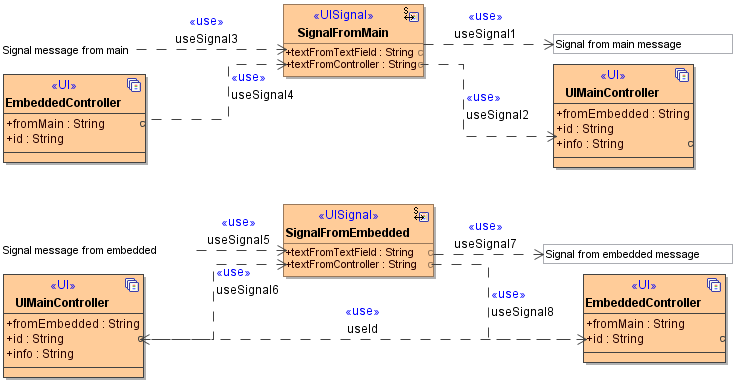- Created by Kirstin Seidel-Gebert, last modified by Annegret Bernhardt on Jan 26, 2024
Example File (Builder project Advanced Modeling/UI):
Each xUML UI web-application must have at least one <<UI>> controller which is representing, in traditional web development, a single HTML page. With the introduction of modern web technologies like jQuery, it is possible to implement a whole web application within one single page. Nevertheless, applications mostly consist of more than one page and this means more than one <<UI>> controller.
Linking Controllers
The linking between <<UI>> controllers is done within the state machine diagram. A link from one controller to the next means also leaving the page and load the next one, meaning terminating the current state machine and load the next one. To model this the Terminate element is used having in addition the stereotype <<UIControllerState>>.
![]()
To apply the <<UI>> controller which will represent the new page that will be loaded, the controller itself needs to be applied to the Terminate element. Which controller will be loaded is specified in the tagged value section of the Termination element.
![]()
Controller Data Binding
In most cases data needs to be passed from one <<UI>> controller to the next, which means that the data between the controllers needs to be bound. This is done by modeling the bindings on the controllers class attributes using <<use>> dependencies.

In the above figure, the NextController and the EmbeddedController use the id and the info attribute of the UIMainController. The bound attributes will be shared between single pages using a url query string: http://localhost:12485/ui/NextController.html?<attributeName>=<attributeValue>&[...]
The attributes, when bound to user interface elements (e.g. text fields, labels) will be automatically applied.
Private and Public Controller Attributes
<<UI>> controller attributes can be set public or private. The effect of distinguishing between these two attributes properties results in if data is past from one controller to the next. If the attributes are set to public, the attributes will be passed to the next controller in form of a URL query string: http://localhost:12485/ui/NextController.html?textMessage=Entry%20saved%20sucessfully!
This link represents the Link from the UIMainController to the NextController. The attribute id is not passed due to it is set to private.
Embedded Controller States
An embedded <<UI>> controller is a own in it closed application which can be embedded into the same page as the e.g. main application is running. Data between the embedded controller and its parent controller are bound the same way as with controllers representing a single page (compare with NextController in the example project).

When the embedButton receives the click event it will not change to a new page, but it will replace the embedPanel template content of the Main State with the template content EmbeddedController content of the Embedded Controller State.
Signal Events
Example Files (Builder project Advanced Modeling/UI):
Signal events allow the sending of messages between embedded controller and main or parent controller and vice versa. The <<UISignal>> is a UML class with attributes being the message content. There is no limit on attributes that can be modeled.

As with the <<UI>> controllers and messages, <<UISignal>> classes are bound to either to <<UI>> using <<use>> dependencies connecting the attributes. A signal should always have a source attribute and a target attribute binding. Also in the case of binding signal events the class diagram type is used.

Signals are sent using <<UITransactions>> where the signal is attached to the Throw Signal tagged value in the UIAction section.
